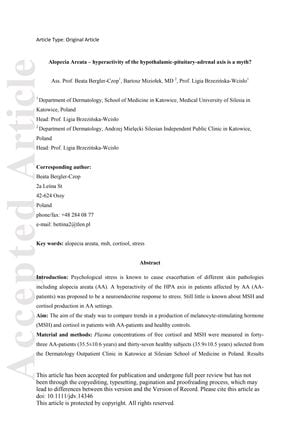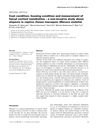Alopecia Areata: Hyperactivity of the Hypothalamic–Pituitary–Adrenal Axis Is a Myth?
May 2017
in “
Journal of the European Academy of Dermatology and Venereology
”

TLDR The study found no significant difference in stress hormone levels between people with alopecia areata and healthy individuals, suggesting that the disease is not caused by an overactive stress response system.
The study investigated the production of melanocyte-stimulating hormone (MSH) and cortisol in 43 patients with alopecia areata (AA) and 37 healthy controls to determine if there was hyperactivity in the hypothalamic-pituitary-adrenal (HPA) axis in AA patients. The results showed no significant difference in the mean plasma levels of MSH between AA patients (5.39 ng/ml) and healthy controls (5.71 ng/ml, p=0.435). Similarly, the mean plasma level of cortisol was slightly higher in AA patients (157.63 ± 91.16 µg/l) compared to healthy controls (123.32 ± 71.28 µg/l), but this difference was not statistically significant (p=0.063). The study concluded that there is no significant disturbance in the production of MSH and cortisol in AA patients, suggesting that the previously proposed hyperactivity of the HPA axis in AA is not supported by the findings. The document also noted that while MC2R mRNA expression was enhanced in AA patients, protein synthesis was decreased, indicating that HPA axis hyperactivity does not lead to increased glucocorticosteroid synthesis due to post-transcriptional deficiencies. The study suggests that AA may be influenced by environmental factors in genetically predisposed individuals and that chronic stress could lead to peripheral desensitization to CRH and a suppression of glucocorticosteroid secretion. Further investigation with more patients is required to fully understand the tendency towards greater cortisol production in AA.

